Introduction
The SWOT analysis is a powerful tool that helps organizations identify and leverage their strengths, address weaknesses, capitalize on opportunities, and mitigate threats. It provides a comprehensive framework for strategic planning, enabling businesses to navigate the ever-changing business landscape with confidence and foresight. In this article, we will explore the key elements of SWOT analysis, including how to identify strengths and weaknesses, common areas to consider, strategies for leveraging strengths and improving weaknesses, and the importance of consulting stakeholders and monitoring customer feedback.
By understanding and applying the principles of SWOT analysis, businesses can gain a competitive edge and drive sustainable growth in today's dynamic market.
Understanding SWOT Analysis
The SWOT analysis serves as a vital strategic planning tool, enabling organizations to identify the internal capabilities and weaknesses, as well as the external opportunities and threats that could impact their operational success. Within this framework, advantages highlight what an organization excels at and its unique benefits over competitors, which could range from a skilled workforce, robust financials, to cutting-edge technology. By contrast, weaknesses are areas that require improvement to avoid competitive disadvantages. External factors, such as market trends and economic conditions, present opportunities for growth and expansion, while potential threats might include increasing competition or regulatory changes. Successful utilization of SWOT analysis results in approaches that not only capitalize on an organization's advantages and address its limitations but also react proactively to the surrounding economic atmosphere.
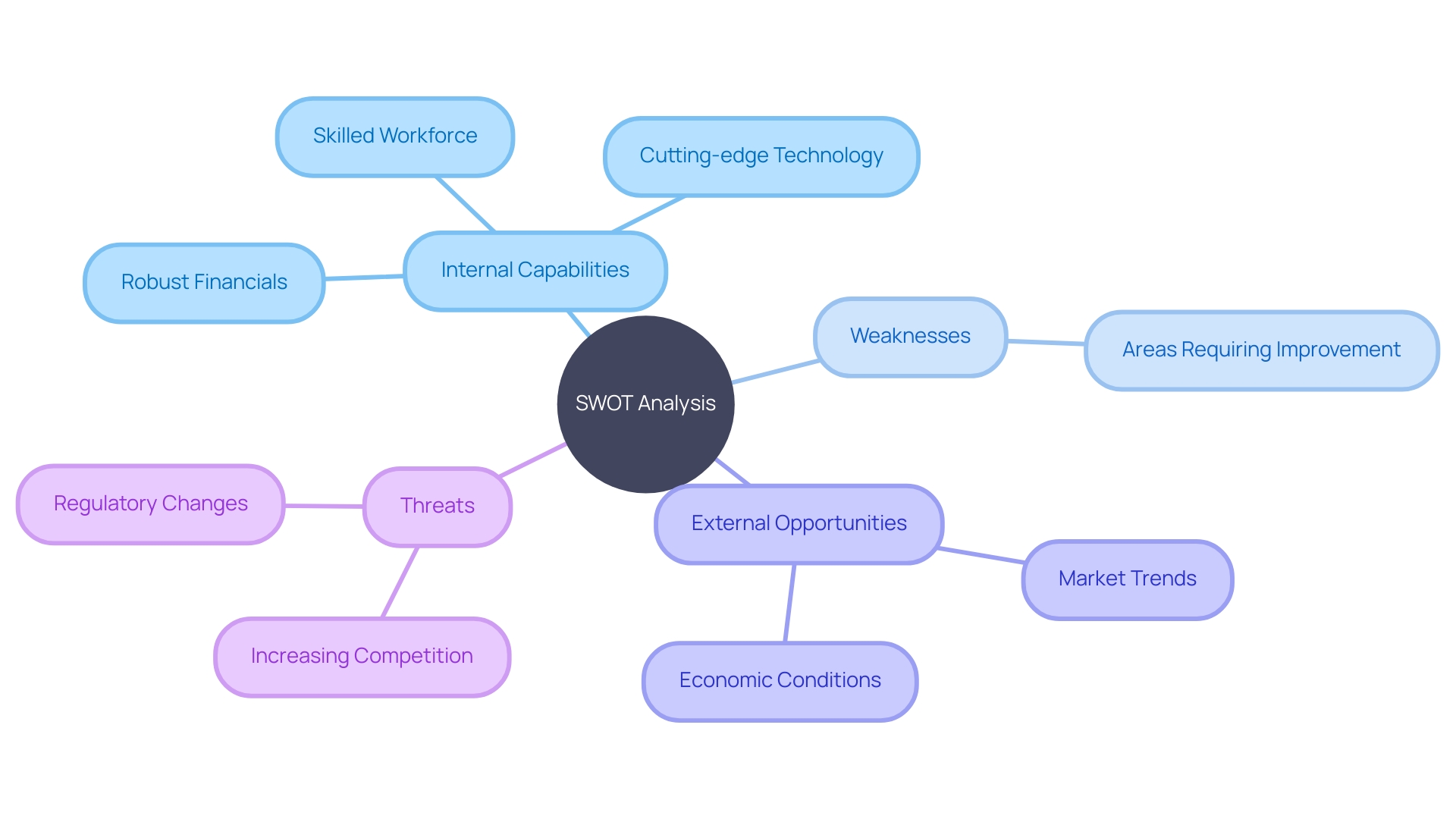
Identifying Strengths: Key Questions and Examples
Identifying the advantages of a company is a crucial step in establishing a competitive advantage. To accurately identify these advantages, businesses should participate in a comprehensive self-assessment by asking critical questions: What distinguishes us from the competition? What unique resources or capabilities are at our disposal? What aspects of our products or services are most valued by the individuals who utilize them? For example, a strong brand, a loyal customer base, unique technology, and a highly skilled workforce are all characteristics of corporate power. These elements are not just assets but also levers for driving growth and success.
Chess.com exemplifies an organization harnessing its distinct advantages - a profound dedication to serving chess enthusiasts and cultivating connections globally. By creating a robust IT infrastructure, the platform caters to over 150 million users, illustrating how a clear focus on a core passion can translate into remarkable growth and user engagement.
Similarly, Last Arrow Manufacturing showcases its proficiency in metal fabrication, wielding expertise in laser cutting, CNC machining, welding, and more. As evidence of its capabilities, the company provides accuracy, punctuality, and outstanding quality control, emphasizing the significance of specialized expertise and knowledge as a competitive edge.
The achievements of Chess.com and Last Arrow Manufacturing highlight the importance of identifying and fostering distinctive corporate capabilities. They are great illustrations of how companies can attain expansion by concentrating on their core competencies and how they can provide outstanding value to their clients.
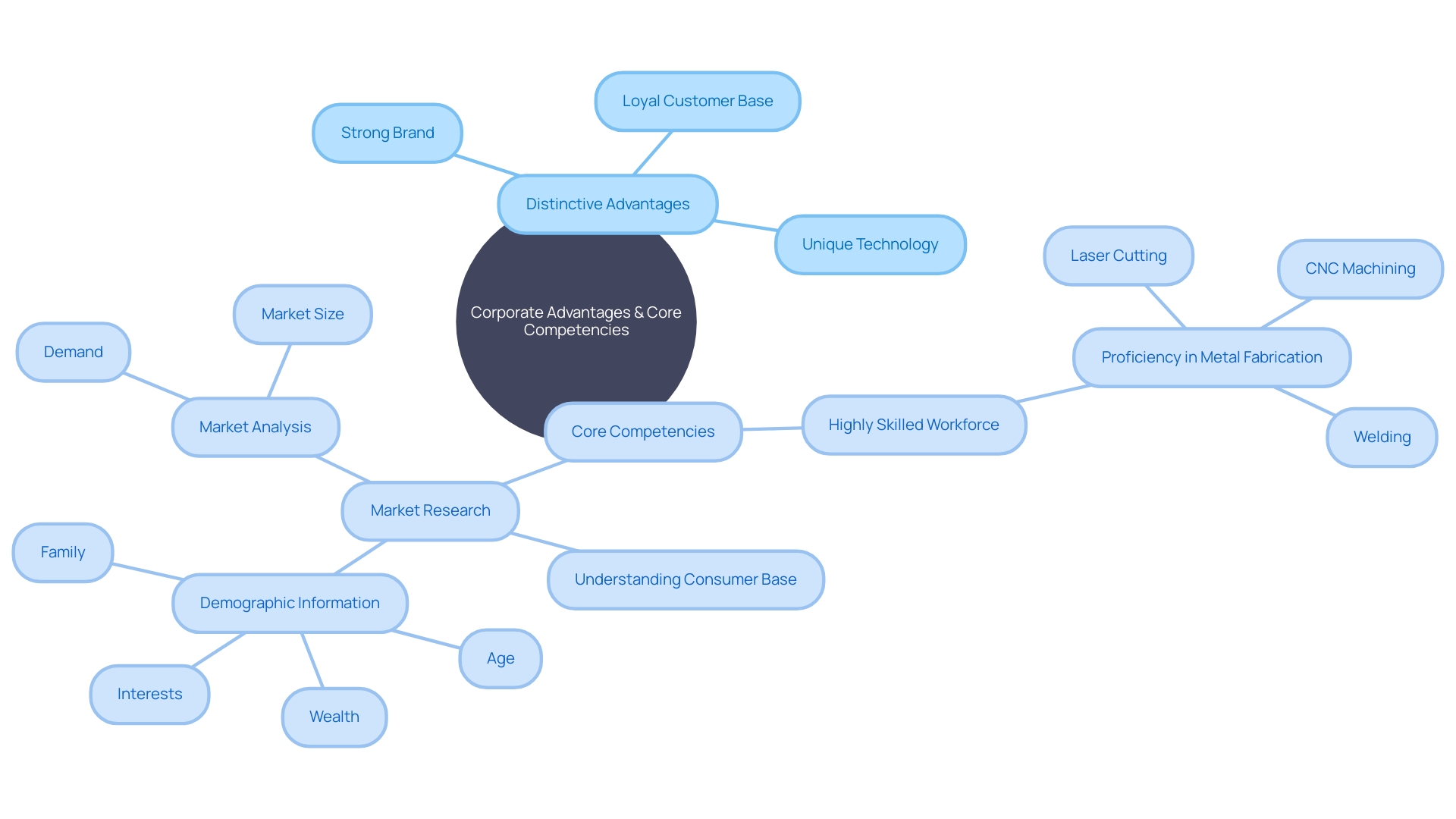
Common Areas to Consider for Strengths
To effectively identify corporate strengths, it's essential for businesses to consider not just the obvious metrics, but also the subtler signs of success. This involves evaluating product or service quality, customer satisfaction and loyalty, brand reputation, and operational efficiency. Moreover, a keen eye on market share and competitive advantage can reveal a company's standing in the industry.
Family-owned enterprises, frequently undervalued, are excellent illustrations of resilience and power, making up more than 70 percent of global GDP and showcasing an extraordinary capacity to adjust and flourish amidst changes. These entities have mastered the art of leveraging their deeply rooted brand reputations and customer loyalty to maintain financial stability and operational efficiency.
In the realm of operational efficiency and supply chain management, companies must regularly review processes to ensure they are not only efficient but also resilient to disruptions. Considering inquiries like the efficiency of inventive tactics and reactions to market shifts can illuminate the organization's agility and capacity to innovate – an essential competitive edge.
Financial performance analysis serves as the backbone of strength identification, where analyzing income statements, balance sheets, and cash flow statements paints a clear picture of financial health. This comprehensive view allows businesses to assess whether they have met, exceeded, or fallen short of financial targets, taking into account revenue growth, profit margins, and cost management.
The importance of marketing and customer engagement cannot be overstated, as these areas directly influence customer satisfaction and brand reputation. The engagement strategies and their outcomes offer valuable insights into the advantages and areas for improvement.
When identifying advantages, it is also advisable to focus on 'weak signals' and anomalies that could indicate important alterations or the rise of innovative company frameworks. This might include changes in financial performance not easily attributed to normal operations or market conditions, as seen in sectors where new entrants pioneer innovative models.
To sum up, when examining the advantages of enterprises, organizations should explore beyond the superficial aspects and take into account a variety of elements, including those acquired from the achievements of well-established businesses and the ever-changing trends in the current market.
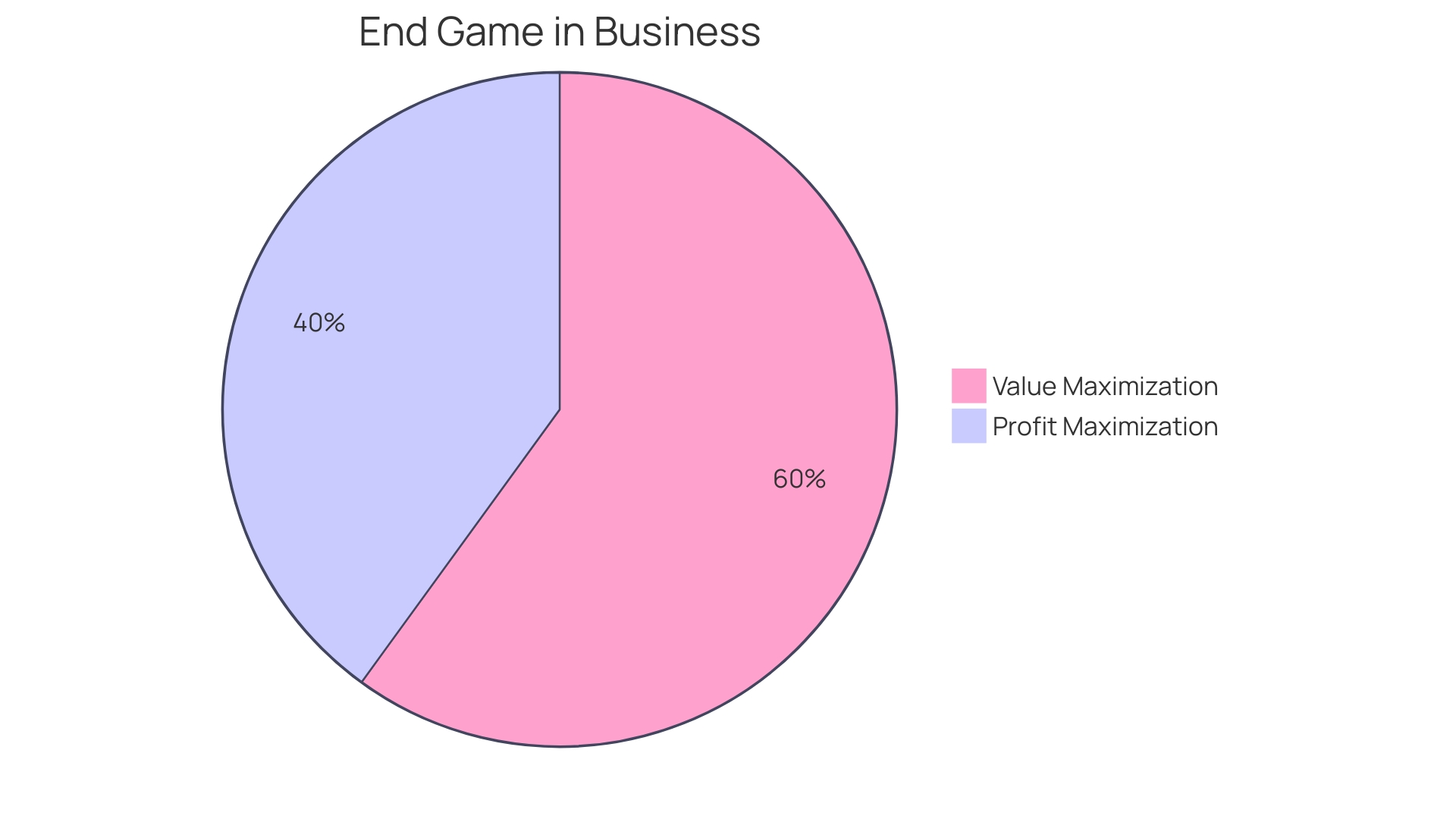
Strategies for Leveraging Strengths
Utilizing the capabilities of a company is crucial for any business that wants to gain a competitive advantage and stimulate expansion. Tailoring strategies to capitalize on unique resources ensures that a company differentiates itself effectively from competitors. For example, directing investments towards research and development can enhance these advantages, as shown by industry frontrunners who recognize that innovation should follow a systematic approach instead of relying on chance. Companies like Microsoft, for instance, have instituted mechanisms to incubate innovative ideas, reflecting their commitment to continuous improvement and capacity for reinvention in the face of challenges.
Moreover, incorporating these advantages into marketing and communication strategies is vital. It’s not just about possessing the capabilities but also ensuring they are recognized by the market. A cohesive strategy that aligns a company’s messaging with its core competencies can enhance its reputation and customer loyalty. As Peter Drucker famously said, “An individual can only perform based on their capabilities,” and this rings particularly true for organizations seeking stability and growth amidst market fluctuations and unforeseen challenges.
In practice, this means being ruthlessly constructive and fostering an environment where creative criticism leads to better solutions. It’s about being proactive, not just in identifying strengths but also in ensuring they are the foundation upon which the future of the company is built. By doing this, organizations can navigate the intricate terrain of contemporary commerce, characterized by the swift rate of technological progress and evolving customer demands, all while remaining faithful to the fundamental principles and abilities that distinguish them.
Identifying Weaknesses: Key Questions and Examples
A comprehensive evaluation of internal weaknesses is a vital step for any organization aiming to stay ahead of the curve. For instance, a winter storm in 2022 swiftly caused a scheduling system collapse for an airline, resulting in almost 17,000 flight cancellations and millions of stranded passengers due to the organization's outdated IT infrastructure. Identifying such potential pitfalls requires asking probing questions beyond the surface level, such as pinpointing areas where the competition outperforms the company or identifying consistent client grievances.
To do this effectively, engaging in open-ended questioning can unearth deeper insights than simple yes-or-no queries. A company may experience apparent weaknesses such as outdated technology or a limited product range, but underlying issues, such as a cumbersome bureaucratic process or a disconnect between services provided and client demands, can be equally detrimental. Instead of concentrating only on monetary measures, organizations should embrace a holistic method to evaluating all aspects of their operations, such as service quality and allocation of resources.
Ultimately, by fostering an environment where issues are not just identified but also rigorously analyzed and addressed, organizations can pivot strategically. Such a process should be based on attentively listening and comprehending the signals from both the team and clients, ensuring that any business adjustment, merger, or acquisition is not only well-planned but also well-executed to truly generate value and avoid the pitfalls of inadequate integration or unaddressed weaknesses.

Common Areas to Consider for Weaknesses
Businesses must scrutinize a variety of areas to pinpoint weaknesses that could undermine their growth and success. These areas include internal processes and systems, workforce competencies, financial limitations, diminishing market share, rising attrition rates of clients, and marketing approaches that may no longer yield results. A well-organized approach to identifying and addressing these vulnerabilities is essential. It requires not only an analysis of potential areas for change but also meaningful engagement with both team members and clients to ensure effective implementation of any strategic adjustments. For example, a company like Western Union, with its longstanding history in financial services, must remain adept at evolving its processes and systems to stay connected with its global customer base. Similarly, the case of a Korean biotech firm facing strategic decisions about licensing proprietary technology underscores the importance of aligning innovations with market needs and social imperatives. Furthermore, strategic assets such as intellectual property, data, sales networks, branding, cash flow, and innovation culture are crucial for growth and must be leveraged effectively. As companies merge, acquire, or restructure, the belief that combining complementary models will automatically generate value is challenged by the necessity of a structured process to support these transitions. In 2023, American enterprises have encountered different obstacles, emphasizing the necessity for available funds and proficient labor forces to promote company expansion and tackle economic indicators. Therefore, recognizing and strengthening against company vulnerabilities while leveraging advantages becomes a crucial element in securing a competitive advantage in a rapidly evolving environment.
Strategies for Improving Weaknesses
When it comes to transforming business weaknesses into strengths, a strategic and proactive approach is key. By embracing continuous learning and development, companies can address skill gaps, ensuring teams are well-equipped to adapt and innovate. Partnerships and external funding can offer the necessary financial support to push boundaries and drive growth. Additionally, implementing systems that gather and act on customer feedback can significantly enhance service quality.
Moreover, recognizing and exploiting weak signals and market anomalies can uncover opportunities for disruptive models and revenue streams. For instance, emerging markets or unusual shifts in financial performance may hint at untapped potential or the need for strategic pivots. Hilti's Tools On Demand program, which revolutionized the commoditized tool market by introducing a subscription model, exemplifies how a bold new approach can revitalize a business.
Corporations also must ensure the alignment of innovation with strategic priorities, leveraging their unique strengths for sustained growth. This can involve utilizing strategic assets such as intellectual property, data, and brand reputation, as reflected in the success stories of organizations like Norsk Hydro, which achieved record financial performance despite challenging market conditions.
Additionally, enterprises should take into account regulatory landscapes and advocate for more predictable legal frameworks, as stability in laws significantly affects strategic planning and risk management. By reducing costs and actively participating in the formulation of legal regulations, companies can create an environment conducive to innovation and long-term success.
Ultimately, an organization's ability to refine its strategy in response to internal and external signals is crucial. As the landscape develops, so should the strategies that guide organizations towards excellence, encompassing every aspect of their operations. The pursuit of quality and excellence must be relentless, fostering a culture that is consistently constructive and unafraid to challenge the status quo for the betterment of the organization.
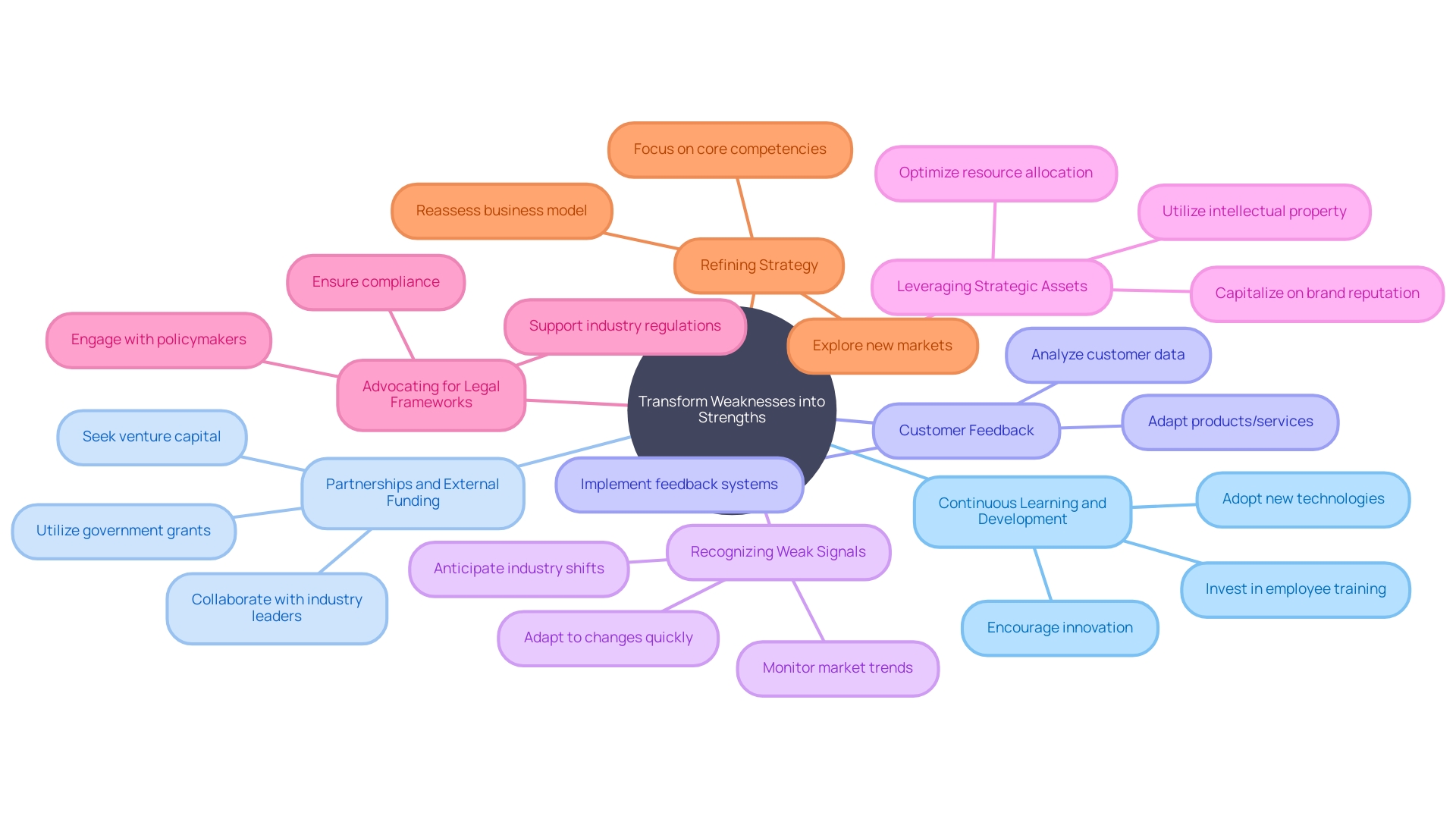
Using SWOT Analysis for Strategic Planning
A SWOT analysis is an essential instrument for strategic planning, enabling businesses to scrutinize internal and external factors that influence their operations. It stands for Strengths, Weaknesses, Opportunities, and Threats. By identifying these elements, companies can structure their strategic initiatives and make enlightened decisions. For example, advantages often make up the organization's distinctive capabilities or resources that give a competitive advantage, such as skilled personnel, robust financial health, or advanced technology. On the flip side, weaknesses might include areas that require improvement or factors that hinder performance. Looking externally, opportunities might arise from market trends or changes in consumer behavior, while threats could encompass new competitors, economic shifts, or supply chain disruptions. Consistently reviewing and enhancing a SWOT analysis helps an organization stay agile, enabling it to adjust quickly to the constantly changing corporate environment and maintain a competitive edge. It's a approach for organizations, at any stage of growth, to reflect on their industry standing and chart a future course that leverages their strengths, mitigates their weaknesses, exploits opportunities, and guards against potential threats.
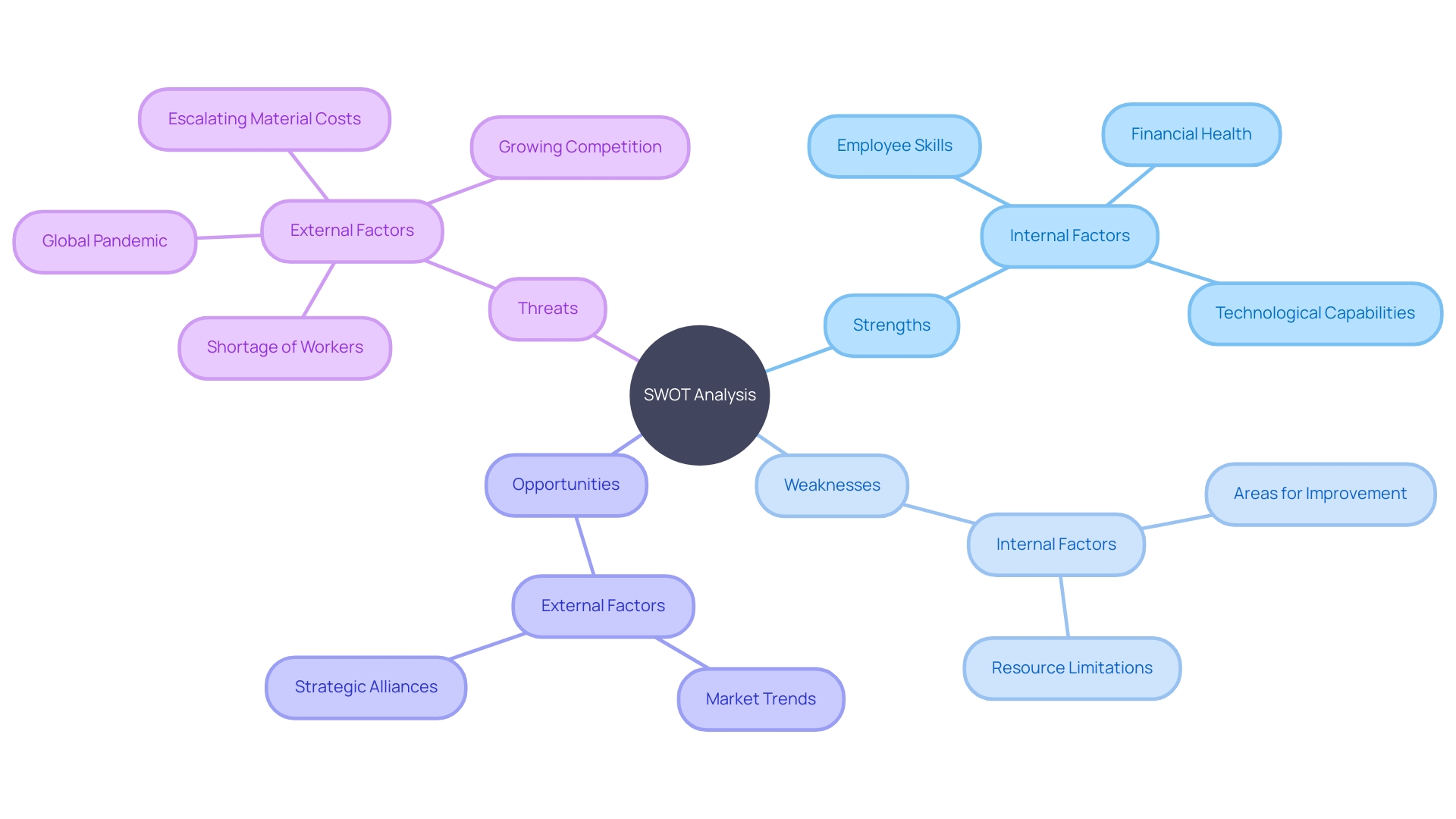
Consulting with Stakeholders for Additional Insights
An encompassing stakeholder analysis is pivotal for businesses aiming to fortify their strategic plans and pinpoint areas for enhancement. By involving not just internal teams but also external entities like customers, suppliers, and subject matter experts, organizations can obtain a comprehensive perspective of their operational landscape. This collaborative approach surfaces insights that might otherwise remain elusive, providing a clearer picture of the organization's capabilities and potential growth areas.
For example, the International Society for Evaluation Education (ISEE) leveraged the Case Collaborative approach to enrich evaluation practices, recognizing that such practices are deeply rooted in the socio-political context and demand practical wisdom. They discovered that out of 148 cases, over half offered simulations of the evaluation process, offering a detailed exploration of the evaluator's thought process in various contexts.
Additionally, as the panorama of cutting-edge AI labs and other emerging sectors changes, companies can find similarities from case studies like California's utility companies, which show the influence of a small number of entities on disastrous wildfire risks.
Effective stakeholder communication strategies, as outlined in various industry reports, also underscore the importance of identifying and engaging with stakeholders. Recognizing who holds interest or influence over a project is the first step in a successful communication plan, followed by a tailored engagement approach that addresses the unique roles and interests of each stakeholder.
In the realm of project management, a comprehensive stakeholder analysis provides a structured approach to assess the interests and expectations of all parties involved, enabling a fair consideration of their needs and contributions to the organization's decision-making processes.
To guarantee a thorough comprehension of stakeholders, companies must inquire critical questions concerning the significance of projects, the desired actions, and the primary beneficiaries. This level of inquiry ensures alignment with stakeholders' expectations and facilitates the development of strategies that resonate with all involved parties.
In summary, by adopting a holistic stakeholder analysis and communication plan, businesses are better positioned to navigate the intricacies of their operations, adapt to emerging trends, and harness the full spectrum of insights available, shaping a more resilient and strategic future.
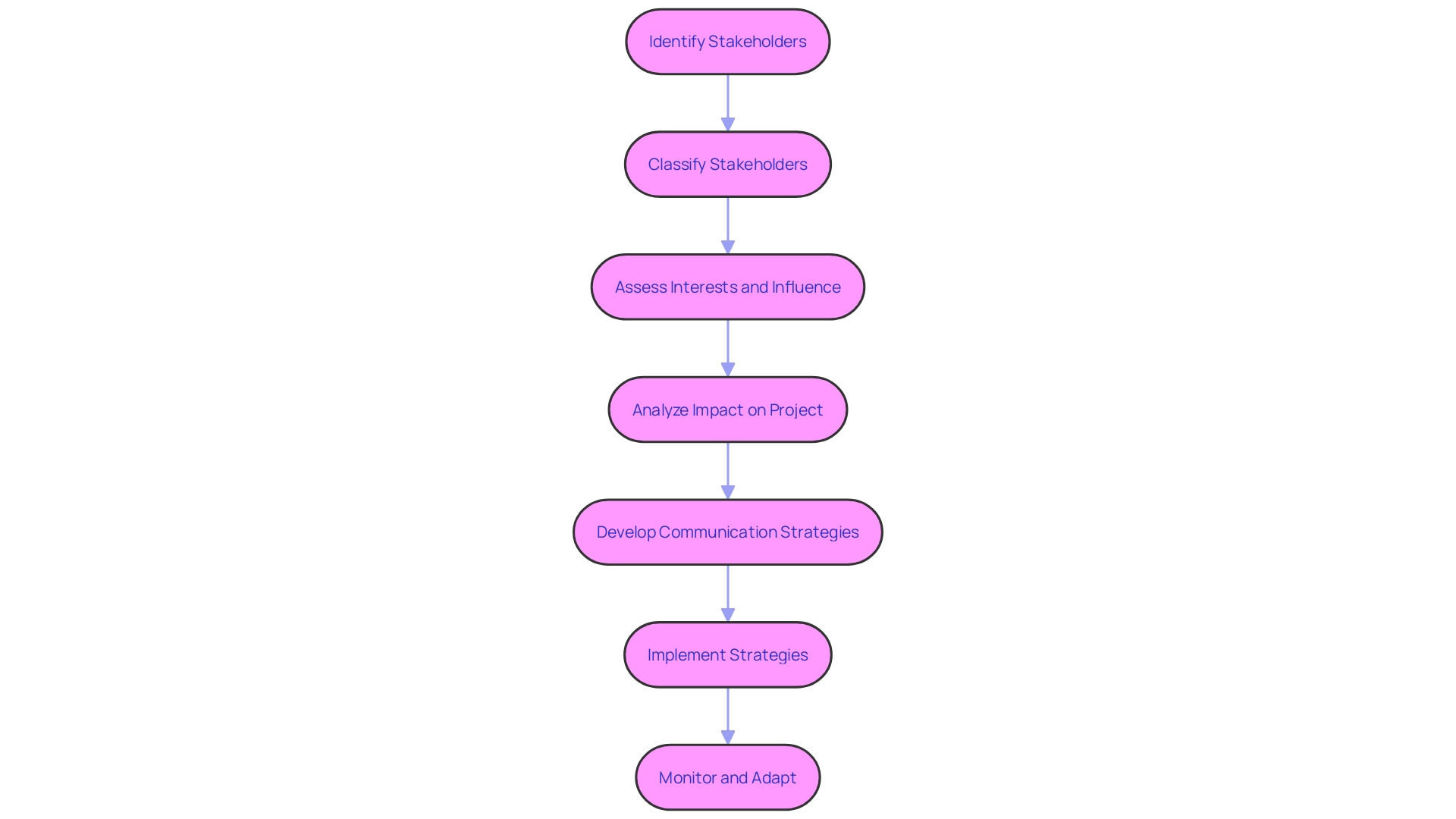
Monitoring Customer Feedback for Improvement
Utilizing feedback from clients becomes a crucial approach in identifying a business's advantages and areas ready for enhancement. For instance, an insurance provider utilized Voice of the Customer (VOC) programs to implement a rapid response mechanism for service recovery. This approach led to a notable decrease in churn—17% of clients have a tendency to abandon services following premium increases or discount expiration, whereas 37% depart after unsatisfactory experiences with products or services. By proactively addressing grievances, the company not only retained at-risk individuals but also leveraged negative feedback as a catalyst for enhancing their offerings and converting more prospects.
In contrast, global satisfaction of clients trends reveal a worrying decline, with 90% of surveyed territories reporting a drop. Despite this, brands that combine state-of-the-art technology with a personalized touch see increased lifetime value of clients. These brands, regardless of their age, prioritize the user experience, indicating that a subtle use of technology combined with human interaction can lead to success.
Drawing inspiration from market leaders, companies should utilize organized feedback mechanisms like surveys and questionnaires, making sure that inquiries are straightforward and relevant to extract actionable insights. Furthermore, social media listening can unearth a wealth of spontaneous consumer opinions, offering unfiltered access to the consumer psyche.
Performance management research highlights the importance of consistent feedback and the recognition of weak signals—unconventional data that might indicate a shift in consumer behavior or the emergence of a disruptive model. In the end, the experience of service to buyers, every exchange a buyer has with a company, is vital in forming a company's reputation and buyer allegiance, which directly affects financial performance.
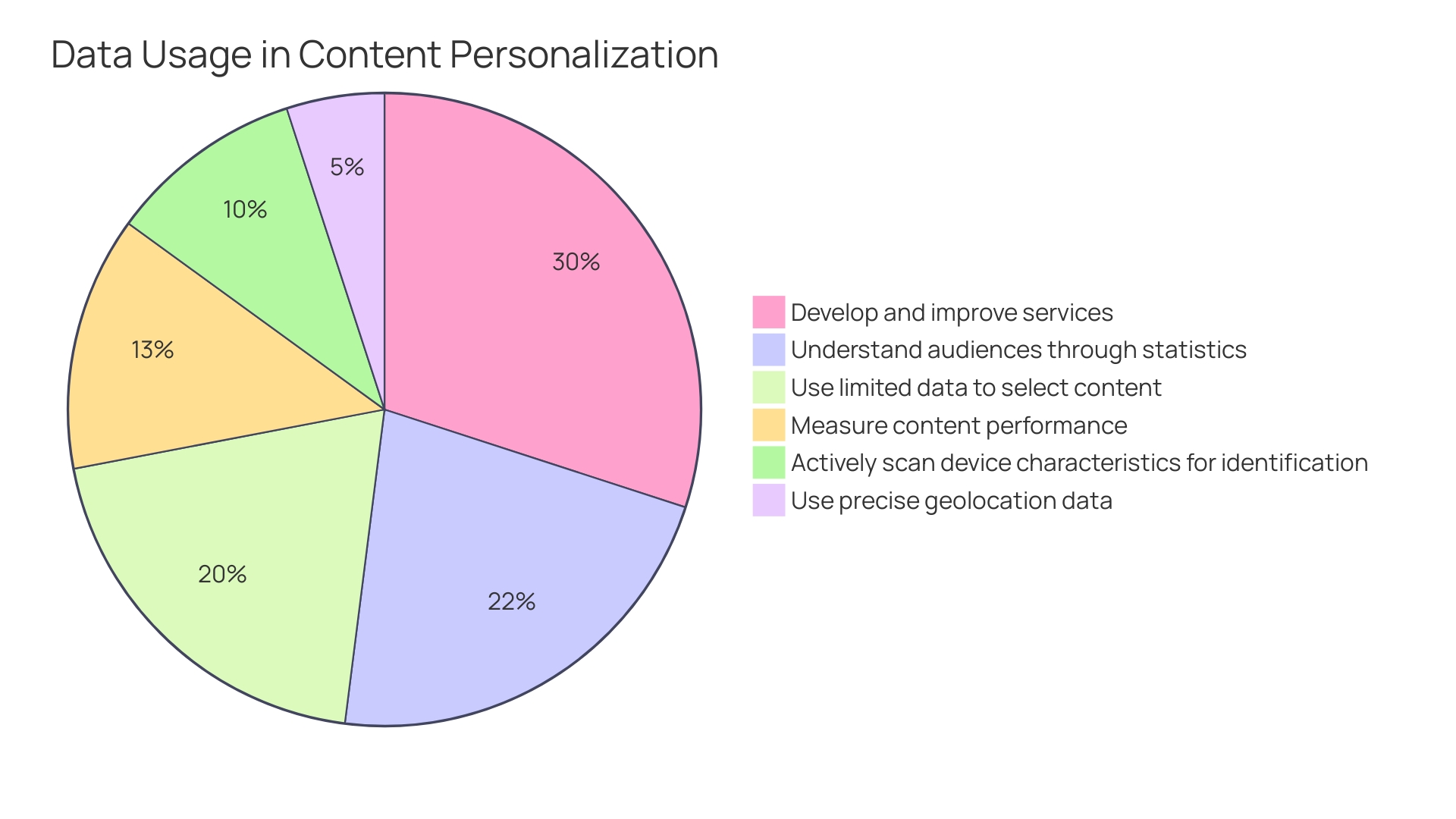
Comparing with Competitors for Strategic Advantage
Achieving a competitive edge necessitates a thorough understanding of the market and a keen analysis of competitors. Insightful market research is fundamental in identifying consumer demographics and their preferences, which reduces risks and informs strategic decision-making. This involves examining factors such as age, wealth, family status, and interests to gauge market demand, size, and economic indicators. By inquiring about important aspects regarding the potential demand for a product or service, the quantity of interested individuals, and the particular areas of these potential clients, companies can gain a deeper comprehension of their target market.
In addition, establishing a competitive advantage involves offering superior value through either cost-effective solutions or premium offerings that justify a higher price tag. The key to this strategy is specificity; a business must articulate its unique selling proposition clearly to resonate with consumers. For instance, instead of assuring prompt shipping, a business might ensure delivery times, making the advantage tangible for the customer.
Building a competitive advantage also depends on an organization's capability to innovate and take calculated risks. This often means pursuing projects that may appear to have a lower return on investment (ROI) but can lead to significant market differentiation. A rigorous analysis of potential revenue against costs, coupled with a firm conviction in the low risk of failure, guides decision-making. However, it's crucial to recognize that traditional cost-benefit analyses may underestimate both the costs and the timelines associated with development projects, leading to missed opportunities for innovation and differentiation.
By benchmarking against industry leaders and scrutinizing their strengths and weaknesses, businesses can pinpoint areas ripe for innovation. This strategic insight, backed by a deep understanding of the market and consumer needs, propels companies forward, enabling them to stay ahead of the competition and continually refine their offerings.
Conclusion
In conclusion, the SWOT analysis is a powerful tool for strategic planning. It helps businesses identify and leverage their strengths, address weaknesses, capitalize on opportunities, and mitigate threats. By conducting a thorough self-assessment, businesses can identify their unique advantages and resources that set them apart from competitors.
To leverage strengths effectively, businesses should tailor their strategies to capitalize on their unique resources. This includes investing in research and development, integrating strengths into marketing and communication strategies, and fostering a culture of continuous improvement and creativity.
When it comes to weaknesses, businesses should conduct a robust assessment to identify areas for improvement. This involves asking probing questions and engaging in open-ended questioning to uncover deeper insights. By embracing continuous learning and development, addressing skill gaps, and implementing systems that gather and act on customer feedback, businesses can transform weaknesses into strengths.
Consulting with stakeholders is crucial for gaining additional insights. By engaging internal teams, customers, suppliers, and subject matter experts, businesses can capture a comprehensive view of their operational landscape. Effective stakeholder communication strategies and thorough stakeholder analysis facilitate a balanced consideration of needs and contributions.
Monitoring customer feedback is essential for pinpointing strengths and areas for improvement. By proactively addressing customer grievances and using structured feedback mechanisms, businesses can enhance their offerings and convert more prospects.
In today's dynamic market, businesses must continuously revisit and update their SWOT analysis to adapt swiftly to changes and uphold a competitive advantage. By understanding and applying the principles of SWOT analysis, businesses can gain a competitive edge and drive sustainable growth.




